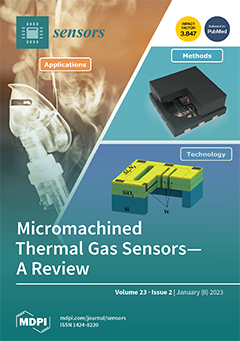Piezoelectric accelerometers using a lead-free (K,Na)NbO
3 (KNN) piezoceramic modified by a mixture of two Bi-based perovskites, Bi(Na,K,Li)ZrO
3 (BNKLZ) and BiScO
3 (BS), were designed, fabricated and characterized. Ring-shaped ceramics were prepared using a conventional solid-state reaction method for integration into a
[...] Read more.
Piezoelectric accelerometers using a lead-free (K,Na)NbO
3 (KNN) piezoceramic modified by a mixture of two Bi-based perovskites, Bi(Na,K,Li)ZrO
3 (BNKLZ) and BiScO
3 (BS), were designed, fabricated and characterized. Ring-shaped ceramics were prepared using a conventional solid-state reaction method for integration into a compression-mode accelerometer. A beneficial rhombohedral–tetragonal (R–T) phase boundary structure, especially enriched with T phase, was produced by modifying intrinsic phase transition temperatures, yielding a large piezoelectric charge coefficient
d33 (310 pC/N) and a high Curie temperature
Tc (331 °C). Using finite element analyses with metamodeling techniques, four optimum accelerometer designs were obtained with high magnitudes of charge sensitivity
Sq and resonant frequency
fr, as evidenced by two key performance indicators having a trade-off relation. Finally, accelerometer sensor prototypes based on the proposed designs were fabricated using the KNN-BNKLZ-BS ceramic rings, which exhibited high levels of
Sq (55.1 to 223.8 pC/g) and mounted
fr (14.1 to 28.4 kHz). Perfect charge-to-acceleration linearity as well as broad flat frequency ranges were achieved with excellent reliability. These outstanding sensing performances confirm the potential application of the modified-KNN ceramic in piezoelectric sensors.
Full article






